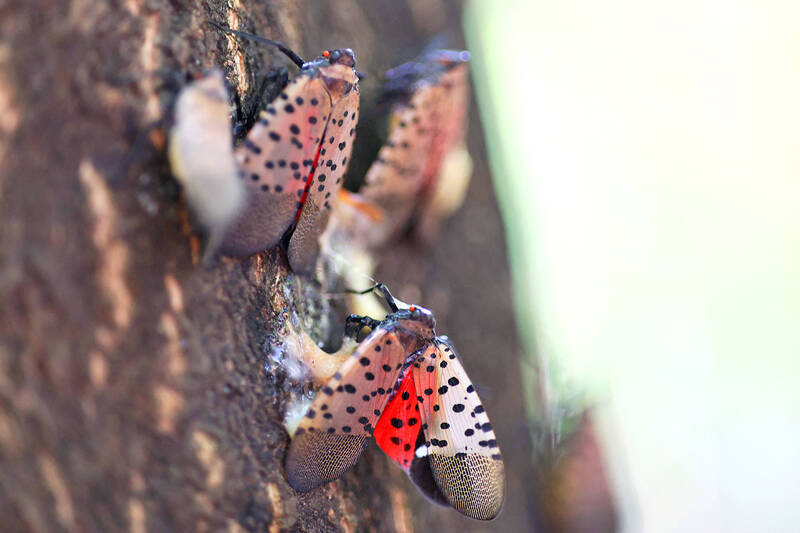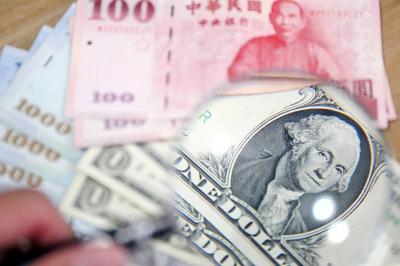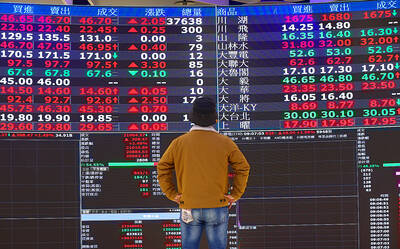At first glance, the spotted lanternfly, or Lycorma delicatula, looks like an elegant butterfly, speckled with black spots on white wings with a splash of bright red, but the insect native to parts of Asia is attacking plants and trees in the US, and officials are moving quickly to try to contain its spread.
“The only good spotted lanternfly is a dead one,” said Amy Korman, an entomologist at Penn State Extension, a part of the university that provides training and education in everything from farming to food safety to landscaping.
The insect was first detected in the US in 2014, in Berks County, Pennsylvania. An egg mass was found in a shipment of stone from China, according to experts who have tracked its progress.

Photo: AFP
The lanternfly — as experts call it — poses no threat to humans or animals, but has caused hundreds of millions of dollars in damage in the US agricultural sector, even though it has only been found in 14 states.
In 2020, a Penn State study found that in Pennsylvania alone, the insect was responsible for US$554 million in annual losses, and the disappearance of nearly 5,000 jobs a year.
Despite huge efforts including quarantines, state officials could not contain the insect population.
“The spotted lanternfly is a very good hitchhiker,” Korman said.
Despite its spectacular wings, the bug is not known to fly long distances.
“These insects are very sneaky. They spread thanks to us. We are taking them across the country, especially their eggs,” Korman said.
Those clusters — which look like clumpy smears of mud — end up on tree bark, outdoor equipment such as lawn mowers or grills, and have even “survived some very harsh winters,” she said.
Once the lanternfly reaches adulthood, it feeds on dozens of crops, ornamental and fruit trees, timber and plants. Once a number of insects feed from the same plant, it dies.
Spotted lanternflies have a particular affinity for grape vines. Scientists have observed dozens, even hundreds of them on a single vine.
Just ask Michael Fiore, who owns a winery and distillery in Maryland that was infested with lanternflies last year.
“We have lost 1,000 vines... The energy has been sucked out — it’s like a vampire,” Fiore said, adding that he is likely to lose half of his harvest this year, and rebuilding would take time.
He said: “2022 was bad, 2023 is just as bad.”
Fiore is not alone — winemakers across Pennsylvania and Maryland have suffered, between the loss of vines and lesser output from those that survived the infestation.
The insects also leave a buildup of sticky fluid known as honeydew on plants, which creates what the US Department of Agriculture (USDA) calls “sooty mold.”
When that mold fully covers a plant’s leaves, it prevents photosynthesis — the process by which plants convert sunlight into chemical energy — from taking place, and the plant dies.
Several US states have tasked scientists with finding a way to eradicate the lanternfly — a true race against the clock, as entomologists say the pest is expected to reach the US West Coast — and its storied vineyards — by 2027 to 2030.
US orchards would also be affected, and Canada is worried too.
California’s wine industry generates US$170.5 billion in annual economic activity and employs 1.1 million people, said the Wine Institute, an advocacy group.
In June, the USDA unveiled a five-year plan to study and combat the lanternfly phenomenon.
“We don’t understand the full picture,” said Matthew Travis, the USDA’s national policy manager for the crisis. “It’s very challenging for us.”
“There are so many things we don’t know, especially in the population dynamics year after year and their uneven distribution,” Travis said, adding that experts have traveled to Asia to study the insect, but those visits were inconclusive.
“It’s been a little difficult, because they never saw the same big phenomena as we have here,” he said.
Those obstacles have made it difficult to calculate the long-term financial consequences of the lanternfly’s emergence in the US.
On a grassroots level, residents have organized makeshift patrols to kill the bugs — because they do not fly far and they are relatively easy to squash, although their relatively large size makes the task rather unappetizing.
In Westchester County, in the northern suburbs of New York City, sniffer dogs are being deployed to find lanternfly egg masses — and giant vacuums are being used to suck up older specimens.
Some have gone so far as to poison the sap of the tree of heaven, one of the insect’s favorite trees that also comes from Asia, but the spotted lanternfly does not have a natural predator in North America.

The US dollar was trading at NT$29.7 at 10am today on the Taipei Foreign Exchange, as the New Taiwan dollar gained NT$1.364 from the previous close last week. The NT dollar continued to rise today, after surging 3.07 percent on Friday. After opening at NT$30.91, the NT dollar gained more than NT$1 in just 15 minutes, briefly passing the NT$30 mark. Before the US Department of the Treasury's semi-annual currency report came out, expectations that the NT dollar would keep rising were already building. The NT dollar on Friday closed at NT$31.064, up by NT$0.953 — a 3.07 percent single-day gain. Today,

‘SHORT TERM’: The local currency would likely remain strong in the near term, driven by anticipated US trade pressure, capital inflows and expectations of a US Fed rate cut The US dollar is expected to fall below NT$30 in the near term, as traders anticipate increased pressure from Washington for Taiwan to allow the New Taiwan dollar to appreciate, Cathay United Bank (國泰世華銀行) chief economist Lin Chi-chao (林啟超) said. Following a sharp drop in the greenback against the NT dollar on Friday, Lin told the Central News Agency that the local currency is likely to remain strong in the short term, driven in part by market psychology surrounding anticipated US policy pressure. On Friday, the US dollar fell NT$0.953, or 3.07 percent, closing at NT$31.064 — its lowest level since Jan.

The New Taiwan dollar and Taiwanese stocks surged on signs that trade tensions between the world’s top two economies might start easing and as US tech earnings boosted the outlook of the nation’s semiconductor exports. The NT dollar strengthened as much as 3.8 percent versus the US dollar to 30.815, the biggest intraday gain since January 2011, closing at NT$31.064. The benchmark TAIEX jumped 2.73 percent to outperform the region’s equity gauges. Outlook for global trade improved after China said it is assessing possible trade talks with the US, providing a boost for the nation’s currency and shares. As the NT dollar

The Financial Supervisory Commission (FSC) yesterday met with some of the nation’s largest insurance companies as a skyrocketing New Taiwan dollar piles pressure on their hundreds of billions of dollars in US bond investments. The commission has asked some life insurance firms, among the biggest Asian holders of US debt, to discuss how the rapidly strengthening NT dollar has impacted their operations, people familiar with the matter said. The meeting took place as the NT dollar jumped as much as 5 percent yesterday, its biggest intraday gain in more than three decades. The local currency surged as exporters rushed to